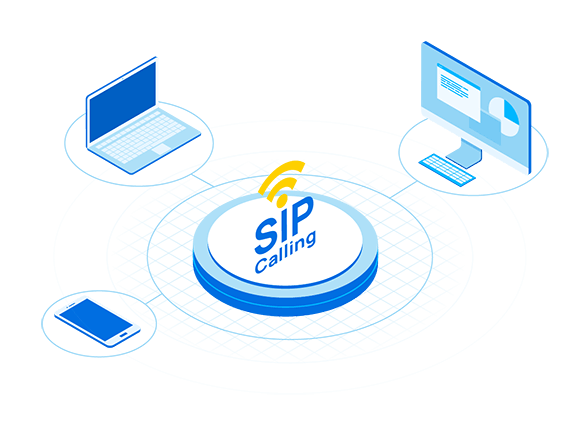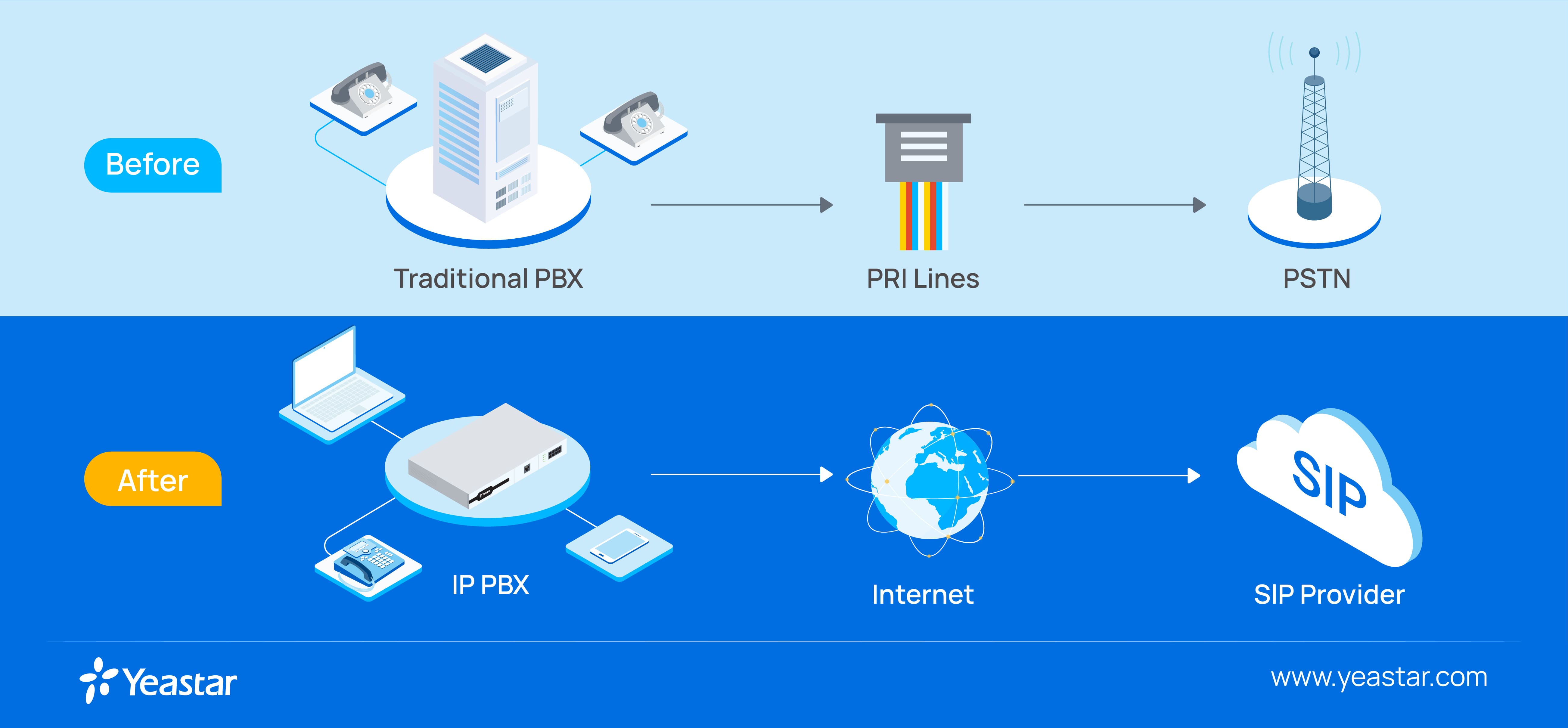 With the development of technology, we have been obviously moving away from miles of copper cables and long, daunting manual installation. But how can you choose the best of new solutions appearing on the market?
With the development of technology, we have been obviously moving away from miles of copper cables and long, daunting manual installation. But how can you choose the best of new solutions appearing on the market?
Below, we explain the intricacies of the Session Initiation Protocol – SIP for short. It can truly transform the communication quality within your organization. Read on to find out what SIP Calling is, how it works, who can use it, and why it should be you!
Table of Contents
- What Is SIP? →
- What Is SIP Calling? →
- How Does SIP Calling Work Exactly? →
- Why Should You Use It? →
- FAQ →
- Final Note →
What Is SIP (Session Initiation Protocol)?
SIP, or Session Initiation Protocol, is a communication protocol that operates over the Internet. It’s used for initiating, maintaining, and terminating communication sessions that include voice, video, and messaging applications.
SIP communication protocol is like a language that allows different devices, such as phones and computers, to communicate with each other. It plays a vital role in connecting people through voice calling, video calls, messaging, and other real-time communication methods over IP networks.
What Is SIP Calling?
As we have already mentioned, SIP stands for Session Initiation Protocol. It refers to a type of signaling protocol, that allows different systems to use an internet connection (Wi-Fi or another technology) to exchange information with the help of a SIP trunk or a SIP channel. The forms of exchanged information can vary, but most companies choose it for phone and video calls.
SIP calling uses both SIP and VoIP technologies, making it a great alternative to traditional phone lines and PRI lines.
From the security and ease of use to lower prices and the possibility to work with it on various devices, SIP calling might bring a great number of benefits to your organization.
How Does SIP Calling Work Exactly?
What makes SIP calling possible is a SIP trunk – a virtually established phone line using SIP technology. Its great advantage is that it enables a direct connection, eliminating the need for PRI lines (Primary Rate Interface) connecting PBX (Private Branch Exchange) to PSTN (Public Switched Telephone Network), This means you can connect directly to your old hardwired number and implement an upgrade to your existing system without having to start from scratch.

Since the link is created with the internet, SIP calling takes advantage of its connection speed, no matter the used technology (Wi-Fi or not), which probably already is top-notch if you work online.
As such, the only thing you physically need will be handsets.
The SIP knows how to check if your recipient is available and capable of taking such calls. Then, it also disconnects automatically when the conversation ends, which reduces the overall costs.
Why Should You Use It? – The Benefits of SIP Calling
It’s Easy
First of all, you don’t need to establish the whole network from the very beginning. You can easily connect your old numbers and simply continue to make and receive calls with the use of SIP technology.
What’s more, you will be able to manage everything from your account, thanks to the intuitive interface of the online control panel. You will be the one responsible for new and old phone numbers, redirecting, extensions, and so on, so everything will be under your control.
With an SIP trunk, all the important features will be consolidated in one device, making it much easier and quicker to train your staff.
It’s Scalable
Since the whole network is cloud-based, once you’re using SIP calling, you can easily adjust it to the needs of your business. Whether your organization is growing or you are looking for ways to reduce costs, it will only take one call to your SIP provider to introduce changes, as most of them offer flexible billing, or even better – some companies allow you to manage your whole SIP phone plan yourself.
There’s no need for additional cables and complicated and time-consuming installation each time you hire a new person. Not to mention that SIP trunking will save you lots of office space.
Grow as you go without the need to try and predict the future so that you can have a phone waiting for every potential employee.
It’s Cheaper
Using SIP technology for audio and video conferencing will significantly lower your business phone bill. Most importantly, it doesn’t charge you for every minute you’re on the phone the same way as a traditional landline or mobile; SIP offers what you can truly call unlimited calls.
Moreover, there’s no hardware involved, which also means that you won’t have to spend time and money on purchases, installation, and maintenance.
Since it’s all cloud-based and works over the internet, it makes an especially significant difference when it comes to international calls (which are then treated as local calls), as they tend to be extremely expensive with a traditional phone.
What’s more, SIP-to-SIP calls are usually free. You can eliminate worries about the high cost of phone setup and focus more on your work.
It’s More Reliable
As SIP calling technology works over the internet, all you need to care about is the quality of your internet connection. Considering that digital processes and availability are key to success in the modern world, you have probably got it covered. As such, you don’t need to worry about the quality of audio and video conferencing.
It will be even better than over a regular phone. Utilizing the SIP communication protocol, calling technology can extend the frequency range and increase the sample rate, thereby enhancing audio quality to achieve HD quality. Consequently, you won’t have any problems understanding the person speaking, which is crucial in the case of conversing with customers or business partners.
Besides, when you use a traditional phone, you’re susceptible to outside problems – bad weather conditions power outages in the neighborhood, or the network failure of your provider. With your own SIP network, you only need to make sure your internet is working.
And in case of a power outage or another failure within your company, you can redirect the phone calls to other locations or mobiles.
It’s Flexible
SIP calls can be received on a variety of mobile and laptop devices, including analog desk phones and VoIP softphones, allowing employees to access the phone system from wherever they are.
It can better enhance productivity and efficiency, and allow employees and customers to connect with each other through devices all over the world.
It’s Built-in Redundancy
Establishing SIP trunking doesn’t mean it will only replace your current phone line – it can also provide other useful features to your business, many of which overlap with the ones offered by VoIP systems (Voice over Internet Protocol).
These functions include the possibility to determine someone’s availability and location, media capabilities, managing phone, and video calls, enabling emergency calls and instant messaging, conferences, and so on.
Therefore, choosing a SIP calling system will help you eliminate at least some redundant software and hardware.
FAQ
Who Can Use SIP Calling?
Well, it’s especially loved by small and medium business owners. Once you’re done setting up the whole network, you will only be reaping the benefits of your decision, including reduced costs, improved quality of communication, and flexibility.
What Is an SIP Account?
It includes your credentials and enables making and receiving audio, and video SIP calls over the internet with the help of the Voice over Internet Protocol technology.
What Is an SIP Address?
Your SIP address is the SIP equivalent of a traditional phone number. It looks like an email address and is unique for each user, so there won’t be any mixups.
What Is an SIP Session?
A SIP session refers to the time when the data is exchanged between devices. With traditional phone lines, it would be called signaling.
What Is an SIP Initiation?
A SIP initiation refers to the beginning, maintaining, and ending of each session. Having SIP trunking means that the technology is fully in control of the process, so it only works when you actually use it.
What Is an SIP Protocol?
A SIP protocol refers to the guidelines followed by all the devices while they’re interacting. In short, it makes SIP trunks and calling work, enabling clear and smooth communication.
SIP or VoIP?
This really is not the right question. It’s not like you need to choose either one; the two technologies are more complementary than rivaling.
VoIP, or Voice over Internet Protocol, is the technology that enables the transmission of audio and video signals via the Internet, complemented by the SIP Internet protocol for session management. As such, SIP calling is more of a result of VoIP’s existence. VoIP needs a system (e.g., a computer) to work while a SIP phone exists outside it.
In short, VoIP is a much wider term, but it’s best to have both working together for the success of your business.
Final Note
As you can see, SIP trunking can truly transform both the internal and external communication of your business.
The most significant advantage is probably its cost-efficiency and affordability, as most companies are constantly looking for ways to reduce spending without worsening the quality of offered services. However, clear and smooth communication is equally vital for the success of your organization.
SIP calling is definitely something that can benefit your business tremendously. You don’t want to be left behind with an outdated phone system. VoIP and SIP phone and video technologies are here to stay – there’s no doubt about it. So, the sooner you start the transition, the better.
Start making SIP calls as soon as possible to boost your productivity!

